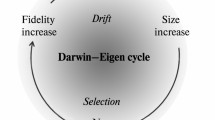Abstract.
We describe a sequential (step by step) Darwinian model for the evolution of life from the late stages of the RNA world through to the emergence of eukaryotes and prokaryotes. The starting point is our model, derived from current RNA activity, of the RNA world just prior to the advent of genetically-encoded protein synthesis. By focusing on the function of the protoribosome we develop a plausible model for the evolution of a protein-synthesizing ribosome from a high-fidelity RNA polymerase that incorporated triplets of oligonucleotides. With the standard assumption that during the evolution of enzymatic activity, catalysis is transferred from RNA → RNP → protein, the first proteins in the ``breakthrough organism'' (the first to have encoded protein synthesis) would be nonspecific chaperone-like proteins rather than catalytic. Moreover, because some RNA molecules that pre-date protein synthesis under this model now occur as introns in some of the very earliest proteins, the model predicts these particular introns are older than the exons surrounding them, the ``introns-first'' theory. Many features of the model for the genome organization in the final RNA world ribo-organism are more prevalent in the eukaryotic genome and we suggest that the prokaryotic genome organization (a single, circular genome with one center of replication) was derived from a ``eukaryotic-like'' genome organization (a fragmented linear genome with multiple centers of replication). The steps from the proposed ribo-organism RNA genome → eukaryotic-like DNA genome → prokaryotic-like DNA genome are all relatively straightforward, whereas the transition prokaryotic-like genome → eukaryotic-like genome appears impossible under a Darwinian mechanism of evolution, given the assumption of the transition RNA → RNP → protein. A likely molecular mechanism, ``plasmid transfer,'' is available for the origin of prokaryotic-type genomes from an eukaryotic-like architecture. Under this model prokaryotes are considered specialized and derived with reduced dependence on ssRNA biochemistry. A functional explanation is that prokaryote ancestors underwent selection for thermophily (high temperature) and/or for rapid reproduction (r selection) at least once in their history.
Similar content being viewed by others
Author information
Authors and Affiliations
Additional information
Received: 14 January 1997 / Accepted: 19 May 1997
Rights and permissions
About this article
Cite this article
Poole, A., Jeffares, D. & Penny, D. The Path from the RNA World. J Mol Evol 46, 1–17 (1998). https://doi.org/10.1007/PL00006275
Issue Date:
DOI: https://doi.org/10.1007/PL00006275




